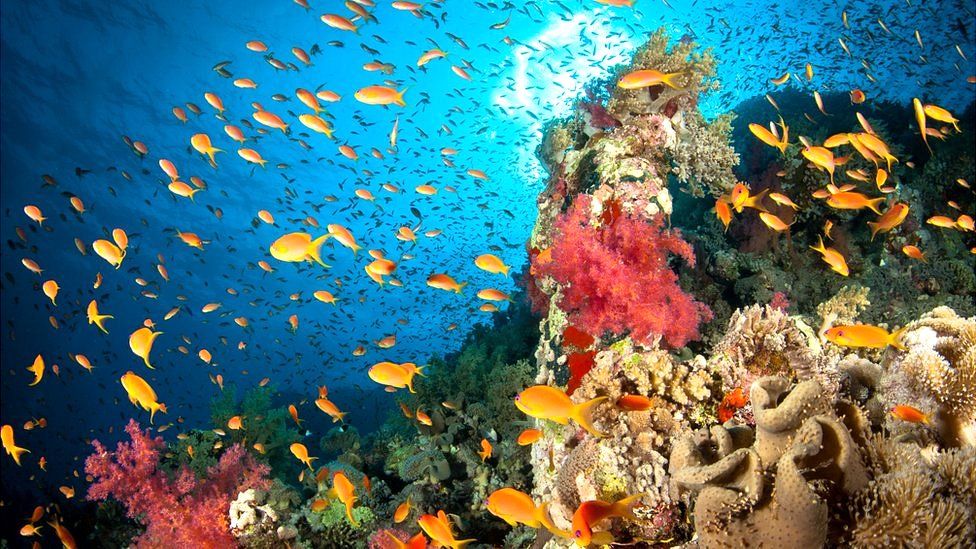 Image source, Getty Images
Image source, Getty Images
Black sea urchins help corals thrive
By Yolande Knell
BBC News Middle East correspondent
The brightly coloured coral reefs of the Red Sea are an underwater paradise, home to dazzlingly beautiful fish and a fascinating array of other marine life.
Despite the impact of climate change, these reefs have shown a remarkable resilience to warming sea temperatures.
But now the mysterious decline of a key species of sea urchins poses a new threat, sparking fears this precious habitat will be increasingly choked up by fast-growing green algae.
The effects on tourism could be devastating.
Israeli researchers first noticed the deaths of black sea urchins near the southern city of Eilat at the start of the year.
The spiky creatures - with defensive spines up to 50cm long - are familiar to scuba divers and snorkelers who flock to the Gulf of Aqaba for its clear waters. They used to carpet parts of the region's coastal reefs.
Image source, Reuters
Image caption,The mysterious disease damages the sea urchins' spines
New surveys show a 90% reduction in the Jordanian resort of Aqaba, mass disappearances in Egypt and losses in Saudi Arabia, thought to be caused by a waterborne parasite.
"We know the pathogen hurts," says Dr Omri Bronstein at Tel Aviv University, placing a dead black sea urchin - its body the size and shape of a flattened tennis ball - into my hands.
He says there are visible signs that the disease paralyses the sea urchin's spines and tiny feet.
"You see what we call necrosis, losing tissue, until you get a bare skeleton. And their mortality is very rapid; the entire process takes about 48 hours."
Sea algae vs corals
Videos shot by scuba divers show how without their defensive spines the infected black sea urchins are soon gobbled up by predatory fish.
It seems likely that fish and human activities, especially shipping, have helped spread the disease.
There could be a profound ecological impact on one of the world's oldest continuously living reefs in the Red Sea, estimated at over 5,000 years old.
Image source, Getty Images
Image caption,Black sea urchins used to blanket the seabed off Israel and Egypt
The sea urchins play a vital role by helping coral larvae to settle and grow, and also by eating algae, stopping it from blocking out sunlight and taking over.
"Sea algae and corals are always competing for space," explains Omri Omessi, a maritime inspector for the Israel Parks and Nature Authority who is based in Eilat.
He says sea algae will spread much faster once the urchins are gone: "Sea algae can spread way faster than corals. Corals, as we know, can grow an average of 1cm in one year. Sea algae can grow 1cm in a day!"
To illustrate the speed with which the disease has spread, he recounts a personal story of taking a diving holiday in Nuweiba in Egypt, about 80km (50 miles) to the south, after he had begun monitoring the loss of the black sea urchins in the very north of the Gulf of Aqaba.
He recalls seeing thousands of black sea urchins in Egypt and thinking "everything may be OK".
"But two weeks later, the people there told me that if I went back to Nuweiba, I would not find even one [of the urchins]. This is really, really violent. It's really, really fast."
A regional phenomenon
Further south along the Egyptian Red Sea coast, Dr Mahmoud Hanafy, a marine biologist at Suez Canal University, has been carrying out his own studies.
"Before you would easily find 20 to 30 per sq m (10.7 sq ft)," he tells me. "Now the black sea urchin disappeared from all the areas I surveyed north of Hurghada to south of Marsa Alam. I could not find a single specimen."
He says this suggests the species is disappearing across the region.
Other countries nearby have also seen dramatic die-offs. These include Jordan, which surveyed 13 sites, and Saudi Arabia, which has checked 113 on its long shoreline, although it has not yet officially announced the results.
Concerns have been raised that the trend could spread to the Arabian Gulf after reported sea urchin deaths near Muscat in Oman. The BBC was also told of losses off the Indian Ocean coast of Somalia.
Opinions differ about the potential consequences.
Scientists I spoke to in Egypt and Jordan stress that their reefs do not yet appear to be suffering from the sea urchins' disappearance. They point out that other marine animals continue to support the corals.
Other experts fear a repetition of what happened 40 years ago in the Caribbean when a pathogen killed off up to 99% of a closely related species of sea urchin. A thriving coral reef turned into an algae field.
They say the effects in the Red Sea may not be clear until winter, when algae blooms naturally.
Surviving pockets
Back in Dr Bronstein's laboratory in Tel Aviv, the race is on to identify exactly what is killing the black sea urchins. One technique they are using is to study environmental DNA, which by chance they had already been sampling from the waters off Eilat when the pathogen first appeared.
"This is already regarded as a treasure because it really is the black box of this event. We just now need to decipher it," Dr Bronstein says.
There are other glimmers of hope.
For about a decade, the Tel Aviv team has been studying black sea urchins in the Eastern Mediterranean after they appeared from the Red Sea as an invasive species.
Image source, Reuters
Image caption,Dr Bronstein is optimistic about international scientific co-operation
While these populations - largely seen as pests - were first to be affected by the recent die-offs, there are some remaining healthy pockets which could become a broodstock, kept in captivity for eventual transfer back to their native environment.
In addition, a few young urchins have emerged which are being monitored in the Gulf of Aqaba.
While individual countries are taking steps to counter overfishing and pollution which pose their own risk to coral reefs, Dr Bronstein also sees encouraging co-operation in this politically complex region, where Saudi Arabia and Israel do not have formal ties.
"The distances between Israel, Jordan, Egypt and further south don't really exist under water," Dr Bronstein says.
He says countries are sharing information and working together better, even if the co-operation often does not go public.
While there is much dividing the countries that border the turquoise waters of the Red Sea, the fate of the black sea urchin shows their shared interest in trying to preserve a unique marine environment.
.png)
 1 year ago
5
1 year ago
5









 English (US) ·
English (US) ·